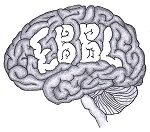In this post I will focus on the interplay of an eye gaze and emotion as they relate to perceiver-target interactions. Eye gaze plays an important factor in social interactions. It cues us to know when someone is talking to us. It can also convey information about the environment. Imagine that you see a mouse run across the room. You yell in fear and look in that direction.  The direction of your eye gaze tells everyone else in a room that there is a potential threat, and where to watch out for it. In this way, emotion and eye gaze complement each other to convey your specific message in a social environment. I’ll explore this interplay from various angles. First, I’ll describe some research about how the gaze conveyed by a target influences a perceiver’s perception of target’s emotion. Next I’ll describe some evidence purporting that a target’s eye gaze can influence the emotional experience of a perceiver. And finally, I’ll discuss how a perceiver’s emotional disposition can influence their gaze towards emotional faces. Overall, I’ll attempt to convey to you that this interaction between eye-gaze and emotion plays an important role in all aspects of social interactions.
The direction of your eye gaze tells everyone else in a room that there is a potential threat, and where to watch out for it. In this way, emotion and eye gaze complement each other to convey your specific message in a social environment. I’ll explore this interplay from various angles. First, I’ll describe some research about how the gaze conveyed by a target influences a perceiver’s perception of target’s emotion. Next I’ll describe some evidence purporting that a target’s eye gaze can influence the emotional experience of a perceiver. And finally, I’ll discuss how a perceiver’s emotional disposition can influence their gaze towards emotional faces. Overall, I’ll attempt to convey to you that this interaction between eye-gaze and emotion plays an important role in all aspects of social interactions.
A target’s facial emotion and eye gaze influence a perceiver
Adams and Kleck (2005) examined how eye gaze influences perception of emotional faces. They first examined whether eye gaze direction would influence which emotions people attribute to neutral faces. Participants were presented with emotionally neutral faces,half depicting direct eye gaze and the other half depicting averted eye gaze. After looking at each face, participants rated the likelihood that the person in the picture would experience the emotions anger, fear, sadness, and joy, on a scale from 1 to 7. The results demonstrated that when looking at a picture of a neutral face displaying direct eye gaze, participants were more likely to attribute approach-related emotions of joy and anger. Conversely, averted target gaze facilitated participants’ attributions of avoidance-related emotions, sadness and fear.

Example of emotionally ambiguous stimuli used in Adams and Kleck (2005) blending fear and anger, depicting direct gaze (left) and averted gaze (right).
Next, they examined how direct versus averted eye gaze would influence participants’ emotional attributions in response to emotionally ambiguous faces. Following a similar procedure, participants made emotional attributions of 4 emotions (anger, fear, sadness, joy) using a 7-point scale. This time, instead of looking at neutral faces, participants were presented with face stimuli that blended two emotions: anger and fear. Consistent with the previous study, they found that direct eye gaze facilitated perceptions of anger in the ambiguous face while averted gaze facilitated perceptions of fear.
In a final study, they measured the extent to which gaze direction influenced perceptions of emotional intensity among highly prototypical emotional faces. Participants viewed faces depicting prototypical representations of anger, fear, happiness, and sadness, depicting either direct or averted gaze and rated the emotional intensity of the target’s emotion. They found that direct gaze increased participants’ intensity ratings when it was depicted on an angry or happy face, and that averted gaze increased participants’ intensity ratings when it was depicted on a fearful or sad face. Therefore, across three studies, they demonstrate a link between gaze direction and emotion: direct gaze facilitates perception of approach-related emotions such as anger and happiness while averted gaze facilitates perception of avoidance-related emotions, such as fear and sadness.
Target’s gaze influences a perceiver’s emotion
Other work has examined the extent to which direct versus averted eye gaze elicits biological responses associated with viewing approach versus avoidance behaviors. Previous work has demonstrated that stronger EEG activation in the left and right frontal cortices is associated with approach- and avoidance-related behaviors, respectively (Van Hon & Schutter, 2006). Furthermore, skin conductance (SCR) has been associated with arousal (Andreassi, 2000). Based on this previous work Hietanen, Leppänen, Peltola, Linna-Aho, and Ruuhiala (2008) set out to explore the effect of direct versus averted eye gaze on participants’ physiological reactions to faces. Recognizing a dearth of research employing real-life faces (and a n abundance of research using photographs of faces), the authors also compared participants’ responses to real-life faces versus photographs of faces.
The participants viewed either a real-life face or a photograph of a face depicting a neutral expression and either direct or averted eye gaze. Researchers collected participant’s skin conductance and EEG data, and asked participants to report subjective ratings of arousal. Consistent with the original hypotheses, the results demonstrate greater right-side EEG activation when participants viewed the face demonstrating direct eye gaze. Conversely, greater left-side EEG activation was observed participants viewed the face demonstrating averted eye gaze. Furthermore, SCR results demonstrate that participants experience greater arousal when viewing faces depicting direct gaze. Importantly, all patterns of significant results were elicited only from the conditions in which participants viewed live faces, suggesting that photographic face stimuli may not be sufficient from eliciting certain approach- and avoidance-related responses.
Perceiver’s emotional state influences target perception
Next, I’ll explore some evidence that a perceiver’s emotional disposition can influence their gaze orientation towards a target (Mogg, Garner & Bradley, 2007). Mogg and colleagues recruited two groups of participants: high-anxiety and low-anxiety individuals to participate in an eye-tracking experiment. Participants’ eye movements were recorded as they looked at an array of stimuli that conveyed fear or anger along a continuum.
They found that both groups of participants preferentially directed their eye gaze towards threat-related emotions of anger and fear (compared to neutral emotional faces). They also found that compared to low-anxiety participants, high-anxiety participants demonstrated stronger gaze orientation towards the threat-related stimuli when the faces depicted highly prototypical angry or fearful expressions. The differences they observed among high- and low-anxiety participants are consistent with theories of anxiety that posit anxious individuals are more sensitive to threat-related cues (Mogg and Bradley, 1998). One way in which this heightened sensitivity can manifest is through greater attention towards threat cues (Mogg and Bradley, 1998).
So to wrap this up, we’ve explored ideas related to ways that emotion and gaze interact to influence all aspects of interpersonal perception. One thing you may notice is that much of the current work focuses on anger and fear, while ignoring many other emotions. It will be interesting to see how the literature develops as we begin to explore other emotional domains.
References
Adams, R. B., & Kleck, R. E. (2005). Effects of direct and averted gaze on the perception of facially communicated emotion. Emotion (Washington, D.C.), 5(1), 3–11. doi:10.1037/1528-3542.5.1.3
Andreassi, J. L. (2000). Psychophysiology: Human behavior & physiological response (4th ed.). NewJersey: Lawrence Erlbaum Associate.
Hietanen, J. K., Leppänen, J. M., Peltola, M. J., Linna-Aho, K., & Ruuhiala, H. J. (2008). Seeing direct and averted gaze activates the approach-avoidance motivational brain systems. Neuropsychologia, 46(9), 2423–30. doi:10.1016/j.neuropsychologia.2008.02.029
Mogg, K., Garner, M., & Bradley, B. P. (2007). Anxiety and orienting of gaze to angry and fearful faces. Biological Psychology, 76(3), 163–9. doi:10.1016/j.biopsycho.2007.07.005
Mogg, K., Bradley, B.P., 1998. A cognitive-motivational analysis of anxiety. Behaviour Research and Therapy 36, 809–848.
